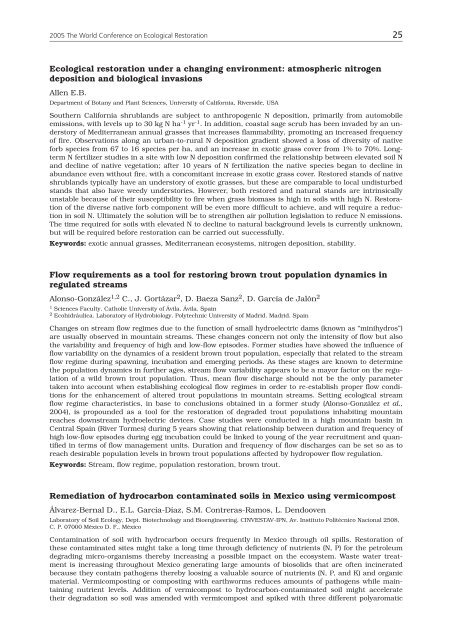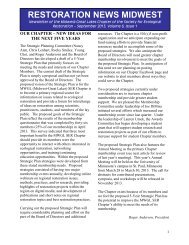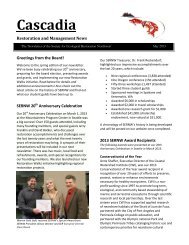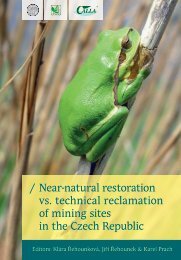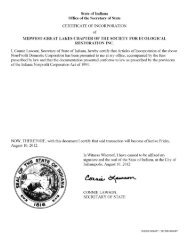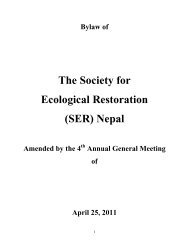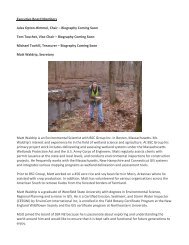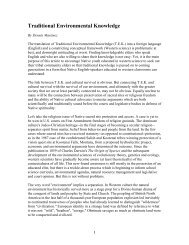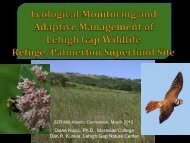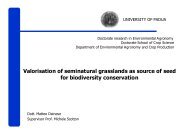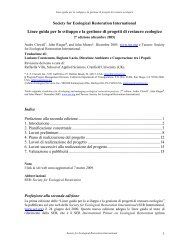THE WORLD CONFERENCE ON ECOLOGICAL RESTORATION
A Global Challenge - Society for Ecological Restoration
A Global Challenge - Society for Ecological Restoration
Create successful ePaper yourself
Turn your PDF publications into a flip-book with our unique Google optimized e-Paper software.
2005 The World Conference on Ecological Restoration 25<br />
Ecological restoration under a changing environment: atmospheric nitrogen<br />
deposition and biological invasions<br />
Allen E.B.<br />
Department of Botany and Plant Sciences, University of California, Riverside, USA<br />
Southern California shrublands are subject to anthropogenic N deposition, primarily from automobile<br />
emissions, with levels up to 30 kg N ha -1 yr -1 . In addition, coastal sage scrub has been invaded by an understory<br />
of Mediterranean annual grasses that increases flammability, promoting an increased frequency<br />
of fire. Observations along an urban-to-rural N deposition gradient showed a loss of diversity of native<br />
forb species from 67 to 16 species per ha, and an increase in exotic grass cover from 1% to 70%. Longterm<br />
N fertilizer studies in a site with low N deposition confirmed the relationship between elevated soil N<br />
and decline of native vegetation; after 10 years of N fertilization the native species began to decline in<br />
abundance even without fire, with a concomitant increase in exotic grass cover. Restored stands of native<br />
shrublands typically have an understory of exotic grasses, but these are comparable to local undisturbed<br />
stands that also have weedy understories. However, both restored and natural stands are intrinsically<br />
unstable because of their susceptibility to fire when grass biomass is high in soils with high N. Restoration<br />
of the diverse native forb component will be even more difficult to achieve, and will require a reduction<br />
in soil N. Ultimately the solution will be to strengthen air pollution legislation to reduce N emissions.<br />
The time required for soils with elevated N to decline to natural background levels is currently unknown,<br />
but will be required before restoration can be carried out successfully.<br />
Keywords: exotic annual grasses, Mediterranean ecosystems, nitrogen deposition, stability.<br />
Flow requirements as a tool for restoring brown trout population dynamics in<br />
regulated streams<br />
Alonso-González 1,2 C., J. Gortázar 2 , D. Baeza Sanz 2 , D. García de Jalón 2<br />
1 Sciences Faculty. Catholic University of Ávila. Ávila. Spain<br />
2 Ecohidráulica. Laboratory of Hydrobiology. Polytechnic University of Madrid. Madrid. Spain<br />
Changes on stream flow regimes due to the function of small hydroelectric dams (known as “minihydros”)<br />
are usually observed in mountain streams. These changes concern not only the intensity of flow but also<br />
the variability and frequency of high and low-flow episodes. Former studies have showed the influence of<br />
flow variability on the dynamics of a resident brown trout population, especially that related to the stream<br />
flow regime during spawning, incubation and emerging periods. As these stages are known to determine<br />
the population dynamics in further ages, stream flow variability appears to be a mayor factor on the regulation<br />
of a wild brown trout population. Thus, mean flow discharge should not be the only parameter<br />
taken into account when establishing ecological flow regimes in order to re-establish proper flow conditions<br />
for the enhancement of altered trout populations in mountain streams. Setting ecological stream<br />
flow regime characteristics, in base to conclusions obtained in a former study (Alonso-González et al.,<br />
2004), is propounded as a tool for the restoration of degraded trout populations inhabiting mountain<br />
reaches downstream hydroelectric devices. Case studies were conducted in a high mountain basin in<br />
Central Spain (River Tormes) during 5 years showing that relationship between duration and frequency of<br />
high low-flow episodes during egg incubation could be linked to young of the year recruitment and quantified<br />
in terms of flow management units. Duration and frequency of flow discharges can be set so as to<br />
reach desirable population levels in brown trout populations affected by hydropower flow regulation.<br />
Keywords: Stream, flow regime, population restoration, brown trout.<br />
Remediation of hydrocarbon contaminated soils in Mexico using vermicompost<br />
Álvarez-Bernal D., E.L. García-Díaz, S.M. Contreras-Ramos, L. Dendooven<br />
Laboratory of Soil Ecology, Dept. Biotechnology and Bioengineering, CINVESTAV-IPN, Av. Instituto Politécnico Nacional 2508,<br />
C. P. 07000 México D. F., México<br />
Contamination of soil with hydrocarbon occurs frequently in Mexico through oil spills. Restoration of<br />
these contaminated sites might take a long time through deficiency of nutrients (N, P) for the petroleum<br />
degrading micro-organisms thereby increasing a possible impact on the ecosystem. Waste water treatment<br />
is increasing throughout Mexico generating large amounts of biosolids that are often incinerated<br />
because they contain pathogens thereby loosing a valuable source of nutrients (N, P, and K) and organic<br />
material. Vermicomposting or composting with earthworms reduces amounts of pathogens while maintaining<br />
nutrient levels. Addition of vermicompost to hydrocarbon-contaminated soil might accelerate<br />
their degradation so soil was amended with vermicompost and spiked with three different polyaromatic


